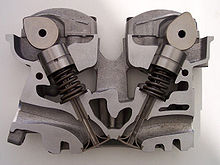DOHC valve control
DOHC valve control (or: double overhead camshaft, in short: DOHC or 2 x OHC) is an international non-proprietary name of a reciprocating piston - four-stroke engine in which the valves of two overhead camshafts per cylinder bank are controlled. DOHC is the most modern type of valve control of an internal combustion engine - the valves are operated by bucket tappets or - rarely - rocker arms. DOHC does not determine whether it is an engine with two or four valves per cylinder. The camshafts are either via timing chain , toothed belt , spur gearsor earlier also driven bevel shafts.
History and technology
The story of the two overhead camshafts begins in 1912 with the Peugeot racing engine developed by the Swiss engineer Ernest Henry ; the four-cylinder engine with a displacement of three liters had four valves per cylinder and won the Grand Prix in 1912 and 1913. The reliability of the valve train - in 1913, Opel used only one camshaft in its Grand Prix engine with four valves - was still in its infancy, so that further development was discontinued for the time being. After the First World War , Horch built his eight-cylinder Horch 8 with this valve control in 1926 , as did Mercedes the engines of the racing vehicles, including the Mercedes-Benz W 165 . In 1954, Alfa Romeo introduced the DOHC engine in production vehicles with the Giulietta . In Formula 1 , these engines with four valves per cylinder have long been established - Denis Hulme won the title with a two-valve engine for the last time in 1967. Since the late 1990s, almost all modern car engines have had two overhead camshafts. In this way, variable control times can be implemented in which inlet and outlet times can be changed independently of one another by adjusting the camshafts during operation.
In 1913 the DOHC engine was first installed in a motorcycle, the Peugeot 500 Sport . Honda won the motorcycle world championship in 1962 for the first time in two classes (125 and 250 cm³) with four-stroke engines and DOHC control, followed by the series engine in the Honda CB 450 in 1965 . The MV Agusta 600 followed a year later , and in 1972 Kawasaki introduced the control system for the “Big Bike” with the Kawasaki Z1 . Few motorcycle manufacturers have done without DOHC valve control since the 1980s.
Two camshafts with four valves have a higher power loss due to friction than a camshaft with two valves. This disadvantage is offset by higher possible speeds and a better degree of filling, which results in a higher maximum torque and more power.
Individual evidence
- ^ Stefan Knittel: Motorrad Lexikon , BLV Verlag, 1981, ISBN 3-405-12226-0 , p. 48.
- ↑ See Fuhrmann-Motor
- ↑ Ludwig Apfelbeck: Paths to the high-performance four-stroke engine . Motorbuch Verlag. 1st edition 1978. ISBN 3-87943-578-2 , pp. 13, 16.
- ^ Gert Hack and Fritz Indra : Formula 1 engines , 1st edition Motorbuch-Verlag 1997, ISBN 3-613-01803-9 , p. 31.
- ^ Gert Hack and Fritz Indra: Formula 1 Motors , 1st edition Motorbuch-Verlag 1997, ISBN 3-613-01803-9 , p. 30.
- ↑ See Harley-Davidson (except V-Rod), Indian , Moto Guzzi
- ↑ Michael Trzesniowski: racing car technology . 2nd Edition. Vieweg and Teubner Verlag, Wiesbaden 2010, ISBN 978-3-8348-0857-8 , p. 533.




